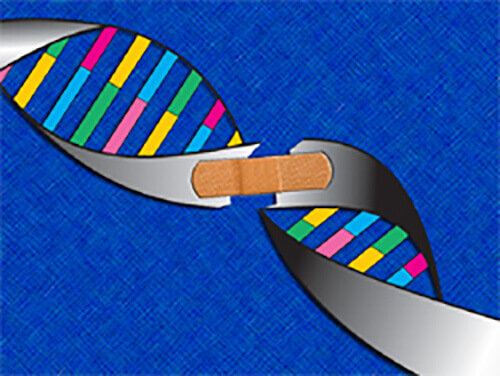



Maintaining genomic integrity is the primary focus of DNA repair proteins. Though scientists have been able to elucidate many of the underlying mechanisms in complex repair pathways, how proteins can find a single damaged base among the billions of DNA molecules has largely remained a mystery. However now, researchers at the University of Pittsburgh School of Medicine and University of Pittsburgh Cancer Institute (UPCI) have demonstrated how Rad4, a protein involved in the nucleotide excision repair (NER) pathway, scans the DNA in a unique pattern of movements called “constrained motion” to efficiently find structural faults in DNA. The new findings could lead to therapies that boost existing drug treatments and counter drug resistance.

“Rad4 is like the cop who is the first responder at an accident,” explained senior study author Bennett Van Houten, Ph.D., professor of molecular oncology at the Pittsburgh School of Medicine, and co-leader of UPCI’s Molecular and Cellular Cancer Biology Program. “The cop can move quickly to recognize where the incident is, and regulate traffic while directing the paramedics arriving in an ambulance.”
Constrained motion allows Rad4 to be quick enough to scan large lengths of DNA rapidly, yet slowly enough that it does not miss structural errors in DNA that could be caused by chemicals or ultraviolet (UV) light. Mutations in the Rad4 gene, also called XPC in humans, and other proteins in the DNA repair machinery are known to cause a genetic condition called xeroderma pigmentosum, in which individuals have a sensitivity to sunlight and are at an extremely high risk of developing skin cancer.
The Pitt researchers tagged normal and mutant Rad4 molecules with light-emitting quantum dots. They then watched them move across strands of DNA suspended between beads using a fluorescence microscope.
“We investigated the dynamic protein–DNA interactions during the damage recognition step using single-molecule fluorescence microscopy,” the authors wrote. “Quantum dot-labeled Rad4-Rad23 (yeast XPC-RAD23B ortholog) forms non-motile complexes or conducts a one-dimensional search via either random diffusion or constrained motion. Atomic force microscopy analysis of Rad4 with the β-hairpin domain 3 (BHD3) deleted reveals that this motif is non-essential for damage-specific binding and DNA bending.”
The findings from this study were published recently in Molecular Cell in an article entitled “Single-Molecule Imaging Reveals that Rad4 Employs a Dynamic DNA Damage Recognition Process.”
What the research team found would suggest that the first responders, consisting of Rad4 and another protein called Rad23, quickly scan the DNA for errors by attempting to bend it. Alterations in the structure of DNA, such as those caused by chemicals or UV light, change the ease with which DNA can be bent. Once a potential error is recognized, the Rad4–Rad23 complex slows down to a constrained motion pattern to examine more carefully a smaller region of approximately 500–1000 base pairs.
Upon confirmation of structural damage, the Rad4–Rad23 complex stays near the scene and flags down the “paramedics,” ultimately comprised of the rest of the DNA repair machinery, to fix the damage. This mechanism, which Dr. Van Houten calls “recognition-at-a-distance,” allows Rad4 to be near the error without impeding the rest of the DNA repair crew.
While more work is needed before these results can be translated into something of clinical value, the results provide new avenues for improving treatment methods, especially in cancer. Resistance is a major problem with current therapies, such as the drug cisplatin, which kills cancer cells by introducing DNA crosslinks similar to UV light. By developing drugs that target Rad4/XPC or other repair proteins, it could be possible to enhance the effects of current treatments when they are used together and also reduce the chances of tumor cells developing resistance.
 Relevant
news
Relevant
news